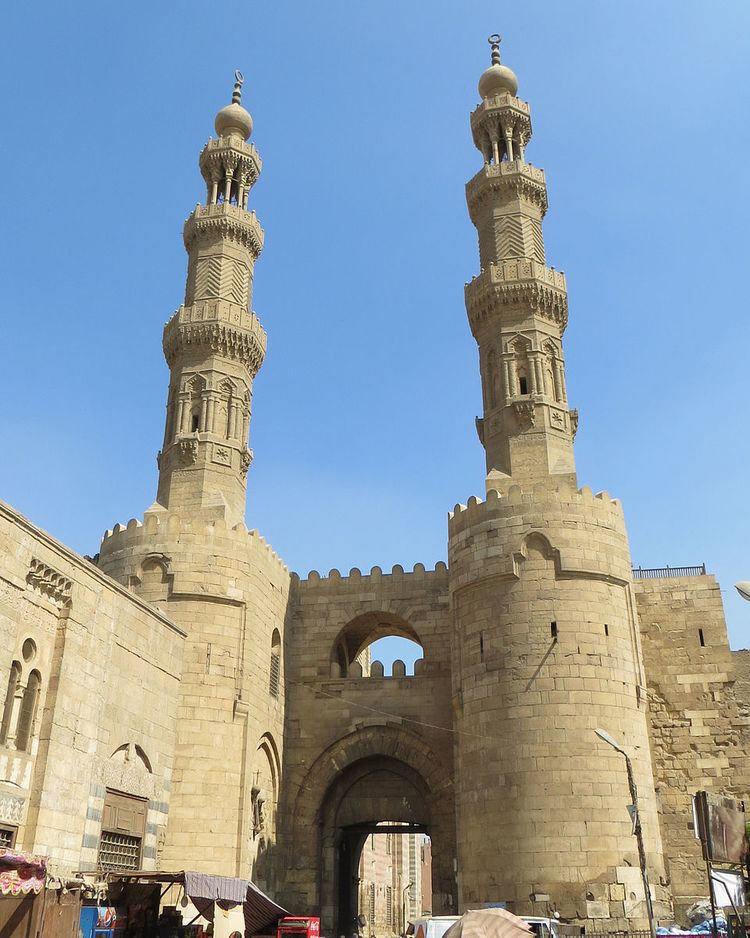 | ||
Address Al Motaz Ldin Allah, Cairo Governorate, Egypt Similar Bab al‑Futuh, Bab al‑Nasr, Mosque of Sultan al‑Muayyad, Muizz Street, Sabil‑Kuttab of Katkhuda | ||
Bab zuweila zuwayla the medieval gate of cairo egypt
Bab Zuweila is one of three remaining gates in the walls of the Old City of Cairo Egypt. It was also known as Bawabbat al-Mitwali during the Ottoman period, and is sometimes spelled Bab Zuwayla. It is considered one of the major landmarks of the city and is the last remaining southern gate from the walls of Fatimid Cairo in the 11th and 12th century. Its name comes from Bab, meaning "Door", and Zuwayla, the name of a tribe of Berber warriors from the western desert, members of which were charged with guarding the gate.
Contents
- Bab zuweila zuwayla the medieval gate of cairo egypt
- Egypt bab zuweila cairo
- Architecture
- Mamluk era
- Mosque of al Muayyad
- Reading the walls
- Excavations
- References
Egypt bab zuweila cairo
Architecture
The city of Cairo was founded in 969 as the royal city of the Fatimid's Dynasty. In 1092, Badr al-Jamali had a second wall built around Cairo. Bab Zuweila was the southern gate in this wall. It has twin towers (minarets) which can be accessed via a steep climb. In earlier times they were used to scout for enemy troops in the surrounding countryside, and in modern times, they are hailed for providing one of the best views of Old Cairo.
The structure also has a famous platform. Executions would sometimes take place there, and it was also from this location that the Sultan would stand to watch the beginning of the Hajj, the annual pilgrimage to Mecca.
Sometimes the severed heads of criminals would be displayed along the tops of the walls. This was done as recently as 1811, when the severed heads of Mamluks from the Citadel massacre were mounted on spikes here.
The corresponding gate on the northern side of the city was the Bab al-Futuh. Futuh is an Arabic word meaning "opening". Bab Al-Futuh still stands strongly on the northern side of the Muizz street.
Mamluk era
Bab Zuweila is featured in a major story from the 13th century. In 1260, the Mongol leader Hulagu was attempting to attack Egypt, after he had successfully forced the surrender of Damascus. Hulagu sent six messengers to Qutuz in Cairo, demanding his surrender. The message that was brought was:
Qutuz responded by killing the six envoys, "halving them at the waist," and displaying their heads on Bab Zuweila. He then allied with a fellow Mamluk, Baibars, to defend Islam against the Mongol threat. Their combined forces, perhaps 20,000 strong, marched north to confront the Mongolian army, which was led by Kitbuqa. This clash of the Mamluk and Mongolian armies was known as the Battle of Ain Jalut, and resulted in a resounding Mamluk victory. The battle was pivotal for the region, as it marked the first time that the seemingly unstoppable Mongols suffered defeat. The battle was a turning point in the expansion of their empire, and effectively set their western border, while confirming the Mamluks as the dominant force in the Middle East, and the beginning of the end of the Mongol presence in the area.
Mosque of al-Muayyad
To the west of the Bab Zuwayla had been a dungeon, which once imprisoned sheik Amir Al Mu'ayyad. While still a prisoner, he had vowed that if he were ever released, he would someday destroy the dungeon, and build a mosque in its place. He was indeed eventually released, and rose to become Sultan of all Egypt. True to his word, he razed the old dungeon, and built a new mosque on the location in 1415, the Mosque of Sultan al-Muayyad.
Reading the walls
Bab Zuwaila has survived from 1092 to the present by humbly accepting layers added to it or letting go of layers subtracted from its original entity. Layers added during later periods are usually distinguished from earlier ones, while layers removed tend to leave traces. To "read a wall" is to visiually detect these differences.
Abrupt changes in a wall such as the unexpected use of different materials, different sizes or types or stone, different mortars or different surface renderings are the visual elements among many that constitute the language of "reading walls". the area between Bab Zuweila and Al-Muayyad Mosque has varied and distinct building layers and is an ideal place for the visual detection of additional periods.
Excavations
Excavations undertaken during the course of conversation have added to the understanding of the gate and its surroundings. the Following is a list of Discoveries made:
